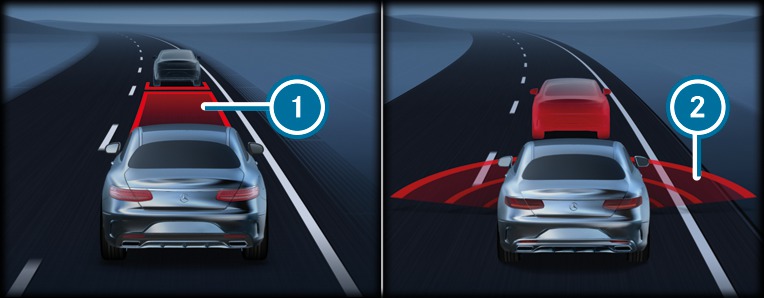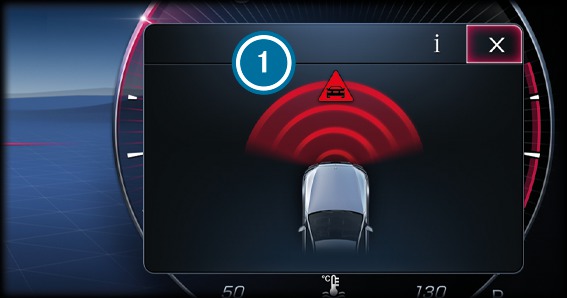Distance warning function
Autonomous braking function
Situation-dependent braking assistance
Vehicles with Driving Assistance Package: Evasive Steering Assist (country-specific)
Active Brake Assist can help you to minimise the risk of a collision with vehicles, cyclists or pedestrians or to reduce the effects of such a collision.
If Active Brake Assist has detected a risk of collision, a warning tone sounds and the  distance warning lamp lights up.
distance warning lamp lights up.

In the Assistance menu, an insufficient distance  to the vehicle in front is displayed in red. If you further reduce the distance, the vehicle in front is also highlighted in red. When the system detects a risk of collision, red radar waves
to the vehicle in front is displayed in red. If you further reduce the distance, the vehicle in front is also highlighted in red. When the system detects a risk of collision, red radar waves  appear in front of the vehicle.
appear in front of the vehicle.
Vehicles with PRE-SAFE®: depending on the country, an additional haptic warning occurs in the form of slight, repeated tensioning of the seat belt.
If you do not react to the warning, autonomous braking can be initiated in critical situations.
In particularly critical situations, Active Brake Assist can also initiate autonomous braking directly. In this case, the warning lamp and warning tone occur simultaneously with the braking application.
If you apply the brake yourself in a critical situation or apply the brake during autonomous braking, situation-dependent braking assistance occurs. The brake pressure increases up to maximum full-stop braking if necessary.

If autonomous braking or situation-dependent braking assistance has occurred, pop up  appears in the driver's display and then automatically goes out after a short time.
appears in the driver's display and then automatically goes out after a short time.
If the autonomous braking function or the situation-dependent braking assistance is triggered, additional preventive measures for occupant protection (PRE-SAFE®) may also be initiated.
Active Brake Assist cannot always clearly identify objects and complex traffic situations.
Give a warning or brake without reason
Not give a warning or not brake
Active Brake Assist is only an aid. The driver is responsible for maintaining a sufficiently safe distance to the vehicle in front, vehicle speed and for braking in good time.
If Active Brake Assist is deactivated,  appears in the driver's display.
appears in the driver's display.
If the system is unavailable or the functions are restricted,  appears.
appears.
Also observe the system limits of Active Brake Assist.
From approximately 30 km/h if, over several seconds, the distance maintained to the vehicle travelling in front is too close for the driven speed, the
 distance warning lamp lights up in the driver's display.
distance warning lamp lights up in the driver's display. From approximately 7 km/h if your vehicle is critically close to a vehicle, cyclist or pedestrian, you will hear an intermittent warning tone and the
 distance warning lamp lights up in the driver's display.
distance warning lamp lights up in the driver's display. Vehicles with PRE-SAFE®: depending on the country, an additional haptic warning occurs in the form of slight, repeated tensioning of the seat belt.
If possible, brake immediately or manoeuvre to avoid the obstacle.
The distance warning function can aid you in the following situations with an intermittent warning tone and a warning lamp:
At speeds up to approximately 250 km/h when approaching vehicles ahead.
At speeds up to approximately 80 km/h when approaching stationary vehicles, pedestrians walking in the direction of travel and cyclists ahead
At speeds up to approximately 70 km/h when approaching crossing pedestrians and cyclists.
At speeds up to approximately 60 km/h when approaching stationary pedestrians and cyclists.
At speeds up to approximately 250 km/h when approaching vehicles ahead.
At speeds up to approximately 120 km/h when approaching crossing vehicles, pedestrians and cyclists.
At speeds up to approximately 100 km/h when approaching stationary vehicles.
At speeds up to approximately 80 km/h when approaching cyclists ahead.
At speeds up to approximately 70 km/h when approaching stationary pedestrians and cyclists.
If the vehicle is travelling at speeds above approximately 7 km/h, the autonomous braking function may intervene in the following situations:
At speeds up to approximately 250 km/h when approaching vehicles ahead.
At speeds up to approximately 80 km/h when approaching cyclists ahead, pedestrians walking in the direction of travel and stationary vehicles.
At speeds up to approximately 70 km/h when approaching crossing pedestrians and cyclists.
At speeds up to approximately 250 km/h when approaching vehicles ahead.
At speeds up to approximately 120 km/h when approaching crossing vehicles, pedestrians and cyclists.
At speeds up to approximately 100 km/h when approaching stationary vehicles.
At speeds up to approximately 80 km/h when approaching cyclists ahead.
At speeds up to approximately 70 km/h when approaching stationary pedestrians and cyclists.
If the vehicle is travelling at speeds above approximately 7 km/h, situation-dependent braking assistance may intervene in the following situations.
At speeds up to approximately 250 km/h when approaching vehicles ahead.
At speeds up to approximately 80 km/h when approaching cyclists ahead, pedestrians walking in the direction of travel and stationary vehicles.
At speeds up to approximately 70 km/h when approaching crossing pedestrians and cyclists.
At speeds up to approximately 60 km/h when approaching stationary pedestrians and cyclists.
At speeds up to approximately 250 km/h when approaching vehicles ahead.
At speeds up to approximately 120 km/h when approaching crossing vehicles, pedestrians and cyclists.
At speeds up to approximately 100 km/h when approaching stationary vehicles.
At speeds up to approximately 80 km/h when approaching cyclists ahead.
At speeds up to approximately 70 km/h when approaching stationary pedestrians and cyclists.
Fully depressing the accelerator pedal or with kickdown.
Releasing the brake pedal.
you manoeuvre to avoid the obstacle
there is no longer a risk of collision
an obstacle is no longer detected in front of your vehicle
Reaction up to speeds of approximately 100 km/h
Warning for oncoming road users through acoustic warning and warning lamp
Autonomous braking application in order to reduce the severity of an accident
Evasive Steering Assist cannot always recognise objects or complex traffic situations clearly.
Moreover, the steering support provided by Evasive Steering Assist is not sufficient to avoid a collision.
Detection of pedestrians, cyclists and vehicles.
Assistance through power-assisted steering if it detects a swerving manoeuvre.
Activation by an abrupt steering movement during a swerving manoeuvre.
Assistance during swerving and straightening of the vehicle.
Reaction from a speed of approximately 20 km/h up to a speed of approximately 110 km/h.
The steering support of Evasive Steering Assist can be cancelled at any time by counter steering.
Full system performance is not yet available for a few seconds after switching on the vehicle or after driving off.
If the system is unavailable or the functions are restricted, the  warning lamp appears in the driver's display.
warning lamp appears in the driver's display.
In snow, rain, fog, heavy spray, if there is glare, in direct sunlight or in greatly varying light conditions.
If the sensors are dirty, misted up, damaged or covered More.
If the sensors are impaired due to interference from other radar sources, e.g. strong radar reflections in multi-storey car parks.
If a loss of tyre pressure or a defective tyre has been detected and displayed.
In complex traffic situations where objects cannot always be clearly identified.
If pedestrians, cyclists or vehicles move quickly into the sensor detection range.
If road users are hidden by other objects or are located close to other objects.
If the typical outline of a pedestrian or cyclist cannot be distinguished from the background.
If a pedestrian or cyclist is not detected as such, e.g. due to special clothing or other objects.
If the driver's seat belt is not fastened.
On bends with a tight radius.
The Active Brake Assist sensors adjust automatically while a certain distance is being driven after the vehicle has been delivered. Active Brake Assist is unavailable or only partially available during the teach-in process.
You can watch an animation on this topic via the following link:


